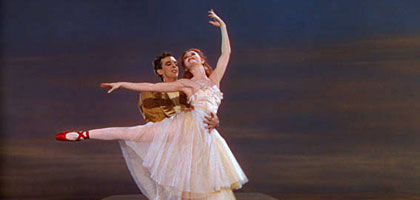Primary navigation


With help from its greatest fan Martin Scorsese, Powell and Pressburger's 1948 masterpiece 'The Red Shoes' is returning to the screen in its full Technicolor glory. But what does a restoration project on this scale really involve, asks Ian Christie
When he saw the great Old Master painting collection bought from the Duc d'Orléans that reached England in 1799, the critic William Hazlitt rhapsodised: “A mist passed away from my sight. A new heaven and a new earth stood before me.” Can we still feel this sense of revelation in the face of cinema's classic images restored to their original glory?
This year's Cannes Film Festival saw a red-carpet premiere of Powell and Pressburger's The Red Shoes, expensively restored by UCLA Archive with funding raised by Martin Scorsese's Film Foundation. It was a starry occasion that certainly helped to raise the profile not only of this Technicolor masterpiece, but also of restoration in general. Scorsese was present to pay tribute to the film's enduring inspiration for him, which began when his father took him to see it as a child at the Brooklyn Academy of Music. At every level - from its portrayal of a bohemian backstage world and of lives dedicated to creating art, to the commanding figure of Anton Walbrook's Lermontov - Scorsese has continued to draw on the film; its influence can be felt in much of his own work.
But what attracted the rest of the Cannes audience, apart from the chance to share Scorsese's enthusiasm in person? Part of the appeal, of course, is the film itself, garlanded with the admiration of Scorsese and so many other film-makers. The story of how a young dancer, Vicky Page (Moira Shearer), is initiated into the mysteries of a touring Russian ballet company by the imperious Boris Lermontov (Anton Walbrook), and how she falls in love with its equally young and talented composer Julian Craster (Marius Goring), is one that has thrilled audiences since the late 1940s. It's credited with both inspiring a wave of interest in ballet, especially when it took off in America (as acknowledged in the musical A Chorus Line), and helping revolutionise the Hollywood musical through its groundbreaking fantasy-ballet sequence.
Sixty years after it was made, The Red Shoes was at the top of Scorsese's long list of films in urgent need of restoration - a list that includes Powell and Pressburger's earlier The Life and Death of Colonel Blimp (1943) and a wide range of other films from around the world. But just what is the significance of such restorations - technical, commercial, promotional or even cultural? At one level, there is no mystery: a film that's 60 years old, made in the now obsolete three-strip Technicolor process, needs restoration if it is to continue to be seen in anything like its original quality. In this case, the original elements survived, but the three camera negatives were far from pristine. Apart from having shrunk to varying degrees, they had a wide range of chemical and embedded blemishes, many cracks in the emulsion and a covering of mould. Yet for all these “daunting” problems, as UCLA's preservation guru Robert Gitt admitted, the three strips represented the filmic equivalent of a painting's original canvas. Many intermediate elements had been made over the years, amounting to over 200 reels in all, but going back to the original offered a unique opportunity to undertake fundamental restoration.
Today, this inevitably means going digital. In place of the restorer's former tools of physical repair and careful optical printing to create a new negative, it is now possible to make a high-resolution scan of every frame - in this case, with three negatives, a total of 579,000 frames - and to remove digitally most of the individual blemishes, with the final output to a digital master. The cost is obviously enormous, putting such work on a par with the restoration of major works of art such as Old Master paintings or church frescos. It was only thanks to very substantial fund-raising and much of the digital repair being carried out relatively cheaply by a vast army of retouchers in India that this could be undertaken for The Red Shoes.
What was shown in Cannes, however, was a 35mm print, produced from the new digital master, returning the film to approximately the technical format in which it was originally seen. This could only be approximate, since the film stock in use in 1948 was the highly combustible cellulose nitrate, which would be discontinued soon afterwards on safety grounds. In fact, what has now been created is essentially an ingenious copy or simulacrum of the 1948 film, even to the extent of retaining the original circular cue marks that signalled the end of each reel for the projectionist. Just as digital photography has been calibrated to mimic the look and feel of the earlier photochemical process - like a computer being taught to 'act human' - so a digital restoration is also an act of reconstruction.
Does this matter, we might wonder? Or rather, what are its implications, since there is no 'analogue' process that would achieve anything like the same quality? A comparison with the world of fine-art restoration points to some of the issues at stake. Paintings and other kinds of picture-making have been undergoing restoration for centuries. Normally this has involved removing discoloured varnish and cleaning the results of candle smoke, which have darkened the painting. It can also mean repairing the actual canvas or removing the misguided efforts of past censors and 'improvers'.
Mostly such work pays obvious dividends, revealing a detailed image where there was previously only a murky fog. But it can also be controversial when it results in a familiar painting suddenly looking startlingly new, as in the case of Michelangelo's ceiling frescos for the Sistine Chapel in the Vatican. This restoration, unveiled in the 1990s, prompted attacks by some who claimed it had radically altered the original colouring, making it relatively bland, even if much brighter. For the endless procession of tourists shuffling beneath it with cameras and mobile phones, the restored ceiling is indeed almost certainly much more vivid than they expect. But then they're not scholars and have nothing to compare it with - except posters and postcards.
An example of the opposite view prevailing is the Mona Lisa, the main focus of mass tourist curiosity at the Louvre. However muted and yellowish this celebrated painting has become, there are definitely no plans to restore it. The Louvre's chief conservator has reminded critics that “the painting is universally famous in its present state” and rejected calls for restoration as merely “sensational” and, crucially, not justified by the excellent physical state of the painting. For many museum curators, there is an important distinction between conservation, which is maintaining works in the state they're in, and giving them the equivalent of a face-lift.
The curtain rises
A painting or fresco is, of course, unique. Once restored, there's no going back. By contrast there are still many versions of The Red Shoes available to show, including some nitrate prints. But the new Red Shoes is already enjoying an international festival career, with screenings in Edinburgh and Bologna following its Cannes debut.
This points to one of the other main benefits of restoration: that it renews a film's reputation. After the ballyhoo of festival screenings, there will be special-event screenings at cinemas - perhaps even short runs, as the film enjoys temporary status as a new release. Given where the cinema industry stands in its slow-motion transition to digital presentation, most of the special screenings will probably be from digital copies, since there will be few prints available. But before purists complain, it's worth noting that digital copies are actually two generations closer to the restoration than any new prints.
For many of the audience, the Cannes screening was actually their first encounter with The Red Shoes on a big screen, having only known it on television or video. So restoration can also restore, even if only temporarily, the 'social projection' experience. And it can add value to a film, in two senses. First, commercial value, as the restored film progresses along the contemporary 'value chain' towards reissue in video formats, its enhanced visual quality helping to justify claims for the Blu-Ray format, and most likely commanding a higher price when relicensed to television in the HD era, and for downloading. And second, cultural value, as journalists and critics report its impact at festivals and the celebrities and opinion formers who are linked with it (Ang Lee, Tilda Swinton and James Gray, for instance, were among those attending the Cannes screening).
This kind of cultural impact is the subject of a recent study commissioned by the UK Film Council, to which I contributed (Stories We Tell Ourselves: the Cultural Impact of UK Film 1946-2006). From studying a representative sample of British cinema of the last 60 years, it's clear that many vintage films are now enjoying an extended life thanks to the variety of ways in which they are referenced across websites, forums and blogs. They have become part of an ongoing discourse that's fed by the chatter of social networking, and also by the validation and exchange of personal enthusiasm that the internet has made possible. The IMDb user comments and discussion threads on The Red Shoes certainly contain indulgent irrelevance, but they also include many intriguing revelations of what the film means to a range of, presumably, younger enthusiasts.
At a more fundamental level, restoration reminds us of the fragility of film as a medium totally dependent on materials and machinery that are all subject to decay and obsolescence. Digital techniques can restore the photochemical experience (and, less controversially, the analogue audio experience), but cannot reliably preserve it. So in preserving the film for future generations to appreciate, it must also be remade through the current proliferating forms of the medium, before being stored once again in photochemical form.
Thinking about the ironies of this process, we might be reminded of the influential media philosopher Walter Benjamin, who pondered 'The work of art in the age of mechanical reproduction' in his 1936 essay of that title. Benjamin argued then that film completed a process of removing the 'aura' which had once surrounded unique works of art, and for him this made film a commendably democratic artform, well suited to the age of revolution. But Benjamin's friends had doubts about his 'aura' concept; 70 years on I would suggest that restoration has in fact become a means of 'reinstating the aura' for classic films, returning them to the condition of artworks.
Rescued from the flux of time and decay, The Red Shoes has now acquired a special kind of immortality, of the kind hitherto only enjoyed by paintings and statues. And the passion to restore and rediscover such works speaks eloquently of our growing attachment to the era of cinema that has already passed.
The restoration of The Red Shoes was supervised by Robert Gitt, assisted by Barbara Whitehead, for the UCLA Film and Television Archive, in association with the BFI, The Film Foundation, ITV Global Entertainment and Janus Films. The restored version is out now on DVD and Blu-Ray